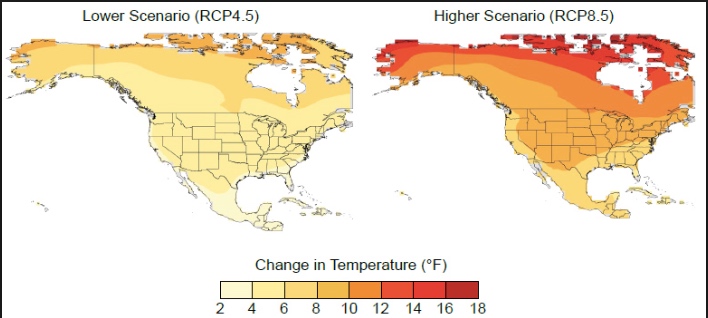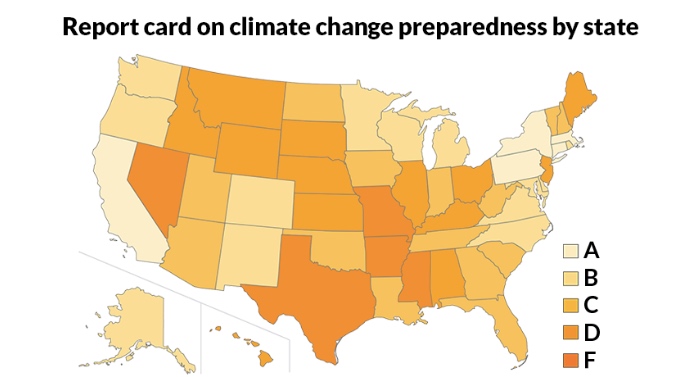On November 23, the National Center for Environmental Information released its fourth report on the state of the climate in a combined effort with 13 other federal agencies. For those who follow climate change closely within the United States, the warnings of the November Climate Change Report were no surprise. The report warns about the continuation of many climate-induced ecosystem changes and their effects on human activity. The main environmental effects occur as either natural disasters or as slowly developing changes such as sea level rise and salt water intrusion.
More specifically, the report warns against rising temperatures, changing rainfall patterns, melting ice, salt water intrusion, damage to coral reefs, coastal erosion, and ocean acidification. It also mentions an increase in air pollution and the frequency of drought, wildfires, flooding, and other natural disasters. The image below shows the low and high end of the projection for rising temperatures within the United States. While all regions will be affected, the North is expected to warm a considerable amount more, which will further contribute to melting arctic ice and rising sea levels.

Temperature warming in the United States | Ars Technica
As climate change progresses, these effects will continue to put stress on people who are reliant on natural resources, disproportionately affecting low-income communities who are less equipped to deal with the impacts. Indigenous peoples as well are more affected by climate change as well, given that they tend to be more reliant on the surrounding natural resources. The range of impacts these communities face are largely reliant on the region of the country they are in. However, some effects can be seen all throughout the U.S.
For instance, as ecosystems change and animals and insects migrate, there is a projected increase in the number of food and water-borne illnesses in the country. Furthermore, changes to ecosystems are projected to cause an increase in allergies, hay fever, and asthma, as well as lead to more temperature-related illnesses such as heat exhaustion and heat stroke. Alongside the physical health concerns, the report also mentions mental health multiple times – emphasizing that long-term environmental stressors or natural disasters can have serious lasting effects on the mental health of a community, despite it being an often-undiscussed topic.
In addition to going over general consequences for the whole nation, the Climate Change Report also identifies the location-specific issues facing different regions of the country:
The Northwest is combating wildfires and faces health-related issues from the smoke.
The Northern Great Plains are facing drought and extreme heat, which is affecting its rural communities most.
In the Midwest, heavy precipitation is also harming farmland, eroding the soil there. The region will also see the most premature deaths from rising ozone levels in the atmosphere.
The Northeast is experiencing flooding, drought, heavy snowfall, and heat waves hurting their water, transportation and energy systems. The region is also expected to see the most deaths resulting from temperature extremes and poor air quality.
The Southeast faces heavy flooding, particularly in Louisiana.
The Southern Great Plains are still reeling from the effects of Hurricane Harvey in 2017, which ended up being one of the costliest natural disasters in United States history.
The Colorado River basin drought has lead to water shortages all over the Southwest. The region is set to be hit by extreme heat and drought in the coming years, as well as an increase in the mosquito-borne West Nile virus.
The part of the report that garnered the most media attention, though, was the estimated cost of climate change to the United States in the years to come. It was predicted that if the United States continues along its projected path for fossil fuel emissions, then the nation will be paying hundreds of billions of dollars in damages by the end of the century.

Preparedness for climate change by state | Science News
So how can we mitigate these effects? Above is an image that rates each state on its preparedness to deal with climate change. While many strategies to combat climate change are tailored to local settings, there are also national level initiatives that need to occur.
The most large-scale effort that the report suggests would be to cut back greenhouse gas emissions through substantial and immediate regulation. It includes the smaller scale, more localized efforts too, though. Depending on the region, these can include flood protection infrastructure, energy efficient building, wildlife havens, fishing regulations, and ecosystem restoration.
There are many things that individuals can do at home, too, to help decrease their carbon footprints and mitigate the effects of climate change. Below are just five of the ways that you can start to be more environmentally-friendly at home:
1. Eat less meat
Meat, and beef in particular, has a disproportionately large carbon footprint in relation to other foods. Livestock farming alone accounts for 14.5% of all anthropogenic greenhouse gas emissions according to the Food and Agriculture Organization of the United Nations. Substituting tofu, chickpeas, tempeh, or other vegetarian forms of protein can help to decrease the carbon footprint of your plate. Here are some more tips to make your meals more eco-friendly.
2. Stop buying from “fast fashion” companies
These are clothing brands that are known for their cheap and trendy fashion, though at the expense of an ever-growing carbon footprint: the industry is now the second-highest polluter in the world, with the first being oil. Instead of buying from these clothing lines, consider shopping for recycled clothing or investigating local stores. Learn more about what you can do here.
3. Line-dry your clothes
According to the Association of Home Appliance Manufacturers, there are over 90 million clothes dryers in America, with an average household creating 2,400 lbs a year in carbon from their dryer alone. Instead, turn to line drying and save on your electric or gas bill as well. Click here to read more.
4. Decrease your vehicles’ carbon footprints
Walking, biking, carpooling, and public transportation are all great ways of using your car less. Find yourself still fairly dependent on driving, though? Invest in a smaller car, and one that uses electric or hybrid energy. Here is more information from the EPA on the greenhouse gas emissions caused by vehicles.
5. Insulate your home
Caulk, insulation, and weather stripping are all ways to block drafts in your home, allowing you to use your heating and cooling energy more efficiently. Some states have programs, such as Energy Upgrade California, that offer incentives for doing so. Click here to find more ways to save energy at home.

